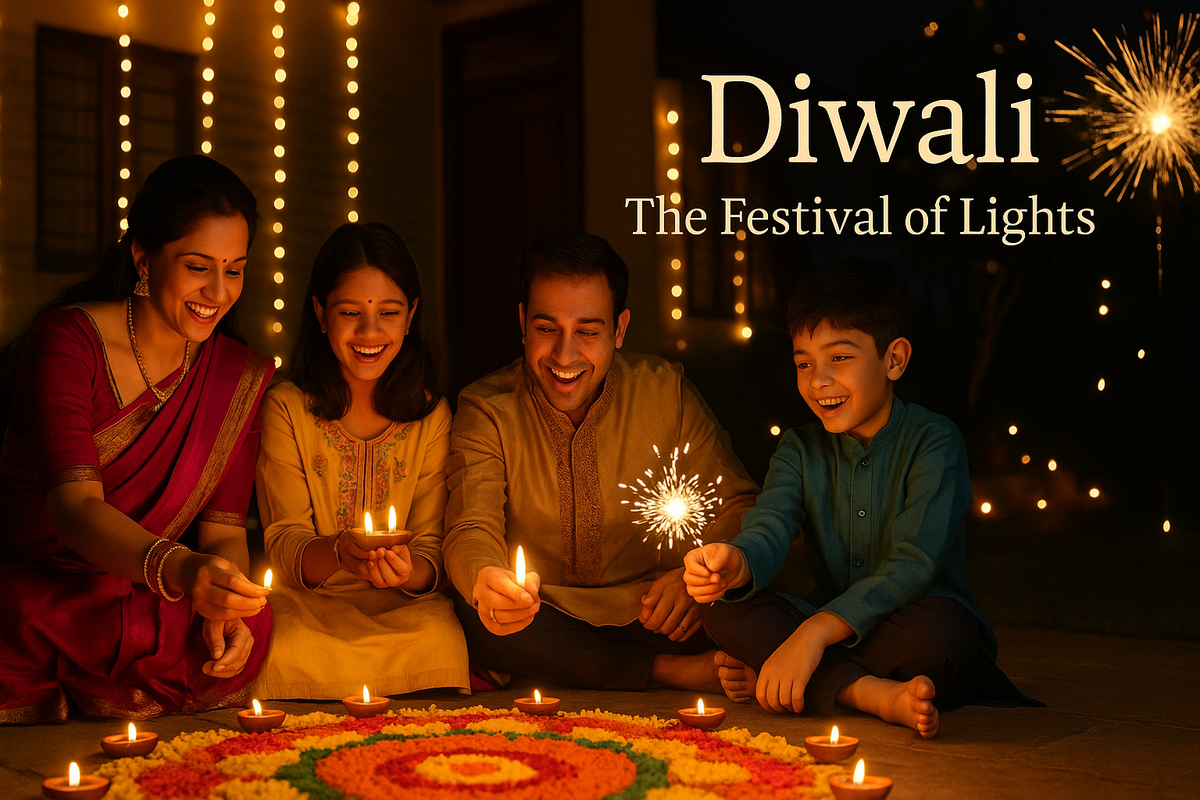How To Celebrate Diwali Festival With Family 🪔🎉

Diwali, also known as the "Festival of Lights," is one of the most celebrated festivals in India and across the globe. 🪔✨ It’s a time when homes are adorned with beautiful diyas (oil lamps), vibrant rangoli designs, and festive lights.
But beyond the sparkle, Diwali is all about togetherness, love, and joy — especially when celebrated with family.
In this guide, we'll walk you through how to make this Diwali extra special with your loved ones while keeping the spirit of tradition alive. 🙏🎉
(Don't forget to explore the amazing traditions in our article on Ancient Festivals of India ! 🌟)
The True Meaning of Diwali 🪔
Before diving into the "how," let’s quickly understand the "why."
Diwali signifies the victory of light over darkness and good over evil. 🌟
It is celebrated to honor Lord Rama’s return to Ayodhya after defeating Ravana, and also worships Goddess Lakshmi for wealth and prosperity.
Family bonds strengthen during this festival as we unite to celebrate life and its blessings. 🧡
Pre-Diwali Preparations: Setting the Stage for Happiness 🧹🎨
1. House Cleaning and Decoration 🏠✨
Start by thoroughly cleaning every corner of your home.
Discard old, unused items — this tradition is symbolic of removing negativity.
Create beautiful rangolis at your entrance with vibrant colors and fresh flowers. 🌸
Light up your home with decorative lamps, fairy lights, and scented candles.
(While planning your decorations, you might also want to learn about other ancient customs at Ancient Festivals of India.)
2. Shopping for New Clothes and Gifts 👗🎁
Diwali is the perfect excuse for a wardrobe refresh!
Dress your family in traditional attire like sarees, lehengas, kurtas, and sherwanis.
Exchange thoughtful gifts with family members — sweets, gadgets, books, and home décor items are popular choices.
3. Planning the Festive Menu 🍛🧁
Cook or order festive dishes like samosas, gulab jamuns, laddus, and paneer tikka.
Plan a family cooking day — involve everyone in making sweets like Kaju Katli and Besan Ladoo! 🍬
Hosting a potluck dinner with extended family adds extra fun.
Main Day: How To Celebrate Diwali With Your Family 🪔❤️
1. Early Morning Rituals 🌄
Begin your day with an auspicious oil bath, a traditional practice believed to cleanse both body and soul.
Wear your finest clothes and prepare for the day's festivities.
2. Performing the Diwali Pooja 🛐
Set up a pooja altar with idols of Goddess Lakshmi and Lord Ganesha.
Light diyas and incense sticks while chanting prayers together.
Teach children about the significance of each ritual, making them feel involved and connected.
3. Sharing Sweets and Gifts 🍬🎁
After the pooja, distribute sweets among family, friends, and even your neighbors.
Surprise your family members with personalized gifts to make them feel extra loved. 🎁💖
4. Hosting Family Games and Activities 🎲🎯
Organize fun games like Antakshari, Tambola, or Diwali-themed quizzes.
Plan a diya painting competition or a rangoli-making challenge! 🎨🏆
Bond over old photo albums and share memories of Diwalis from years past. 🥰
5. Bursting Crackers Safely 🎆🧨
Light fireworks responsibly — use eco-friendly crackers if possible.
Ensure children are supervised, and keep a bucket of water handy.
Celebrate with sparklers and flowerpots to minimize air pollution.
6. Family Dinner and Storytelling 🍽️📖
End the night with a grand Diwali feast prepared together.
Share mythological stories about Diwali and ancestors' tales, passing culture and traditions down to the next generation. 🌟
Modern Ways to Celebrate Diwali With Family 🎇📱
1. Virtual Diwali Celebrations 🌐
If family members are far away, host a virtual Diwali party!
Share gifts via e-commerce, have online games, and even conduct a digital pooja together. 💻❤️
2. Eco-Friendly Diwali Ideas 🌱
Use biodegradable decorations and avoid plastic.
Opt for LED lights to conserve energy.
Plant a sapling as a family tradition to celebrate growth and prosperity. 🌳
3. Charity and Volunteering 🫶
Involve your family in giving back to society by donating clothes, food, or money.
Visit old-age homes or orphanages to spread festive cheer beyond your home. 🎁💖
(Also, don't miss out on the festive spirit of Raksha Bandhan — a beautiful festival celebrating sibling bonds!)
Why Celebrating Diwali with Family is Special 🌟
Strengthens emotional bonds. 🤝
Helps children learn traditions. 👶🏽📖
Creates memories that last a lifetime. 🏡💖
Encourages gratitude and togetherness. 🙏
Remember, it’s not about extravagant parties — the best Diwali memories are made with love, laughter, and light! 🪔❤️
Final Thoughts 🌟
Diwali is a magical time to pause our busy lives and reconnect with family, traditions, and spirituality. 🕊️
From cleaning and decorating your home to performing rituals and enjoying sumptuous meals together, every step is an opportunity to bond and celebrate life.
So, this Diwali, ditch the hustle and bustle — embrace simplicity, love, and light with your beautiful family! 🏡🎉
(And for more fascinating insights, dive into the rich heritage of Ancient Festivals of India and experience the vibrant celebrations of Raksha Bandhan! 🌟)





